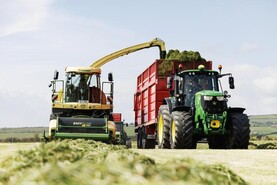As the wet weather continues, every day that rain falls decreases the likelihood of stock remaining outdoors much longer.
Ground conditions are now wetter than at any point this year and although a bite of grass remains, poaching of gateways and around troughs and ring feeders is becoming more of an issue.
Almost all stock have been offered bales of silage or haylage for more than a month now, in response to several instances of grass staggers in the locality.
Unfortunately, both the bales and the mineral buckets failed to prevent one cow succumbing to staggers. Despite being treated almost at the onset of symptoms and lots of care and attention, the cow never got back to her feet and ended up going to Grayshill knackery nearly three weeks later.
Harvest
Thankfully, harvest was gathered successfully in mid-September. We managed to get 45t from the 20ac of spring barley and although one field yielded disappointingly, the other pleasantly surprised, in spite of lodging quite badly and being hammered by the crows.
However, baling the straw proved to be a challenge. The weather at the time was good, but strong winds on the day meant it was a case of “guess where the rows should be”. We ended up chasing the straw around the field, and despite being tempted to give up at least a couple of times, 118 bales of fairly good straw were secured.
But the following day, it became apparent how much had been missed, necessitating the haybob to be pressed into service. After a second run over most of the field, a further 29 bales were then baled up.
Housing
Ahead of housing, most of the sheds have been mucked out and washed. To get the job finished we need stubbles cleared and dry weather, to avoid bringing muck onto the roads.
In the cattle sheds, we started last year to replace all older bulkhead and halogen lights with new LED lights, and it is now complete. It may take time for the savings on energy consumption to cover the initial cost, but the output from the new lights is impressive.
Hopefully the cows will all be in calf by housing. One group was pregnancy diagnosed in early August and this confirmed the suspicion that the older of our two bulls had stopped working. That meant purchasing another bull, but unable to find a Limousin within the budget, a Hereford bull was found and put straight to use.
The first calves from the Limousin bull purchased last October are also starting to arrive. Initial impressions are that his Estimated Breeding Values (EBV) figures for ease of calving are accurate, although one cow required assistance due to the calf coming backwards. The rest have calved themselves, with one set of twins.
Lambs
The majority of lambs were sold prime at Dumfries the week before the schools went back in August. The Texel crosses averaged £75.50 and the Zwartbles £71.50.
All but a few of the Zwartble ewe lambs will be kept as the flock continues to grow. We’ve also purchased a Beltex cross Texel ram which will go to the two or three crop ewes, with the lambs and gimmers going back to the Zwartble.






 This is a subscriber-only article
This is a subscriber-only article










SHARING OPTIONS: